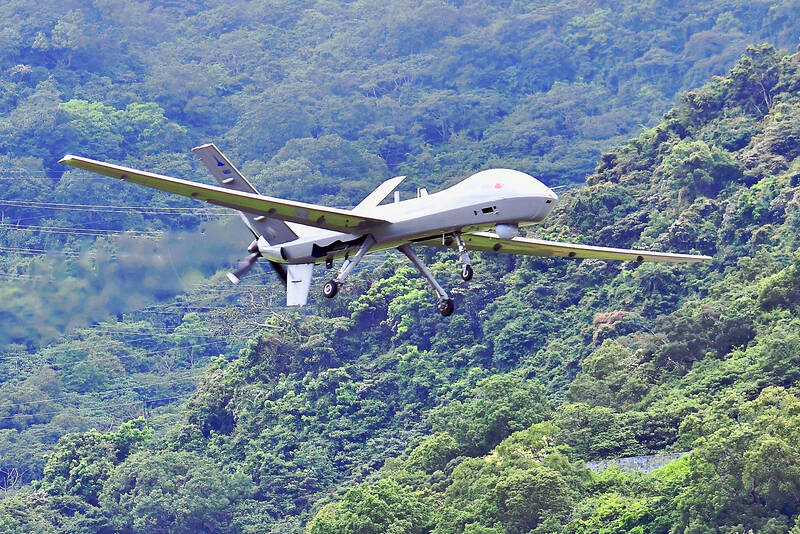The indigenous uncrewed combat aerial vehicle (UCAV) Teng Yun 2 has not passed its combat readiness testing phase, with initial results showing its design has room for improvement, a source with knowledge of the matter said yesterday.
Further combat testing would be conducted after making hardware and software changes to improve the drone’s performance, the source said.
The Teng Yun 2 combat and reconnaissance drone, or “Cloud Rider” (騰雲二型), developed by the Chungshan Institute of Science and Technology, evolved from a first-generation drone that did not meet the military’s needs.

Photo: Yu Tai-lang, Taipei Times
The second-generation version is a long-endurance, satellite-guided drone that has a new engine as well as an improved and enhanced configuration and flight control system compared with the first-generation prototype.
It is capable of autonomous takeoffs and landings, is equipped with satellite navigation, and can stay in the air for nearly 24 hours, the source said.
The new version completed its first-phase flight tests in March 2022, and the institute trained air force members to use it in January and February last year before it entered combat readiness testing in March.
Initial combat testing results indicated that there was still room for improvement, the source said, adding that efforts to improve the design of the new version are under way and that further tests would be carried out soon.
The combat readiness testing phase is the final hurdle the drone has to clear before it can be manufactured for military use.
Under the Ministry of National Defense’s five-step process for developing weapons, drones need to make it through an initial conceptual design stage, an engineering development stage, initial weapon testing, and combat readiness testing before they can enter mass production.

‘DENIAL DEFENSE’: The US would increase its military presence with uncrewed ships, and submarines, while boosting defense in the Indo-Pacific, a Pete Hegseth memo said The US is reorienting its military strategy to focus primarily on deterring a potential Chinese invasion of Taiwan, a memo signed by US Secretary of Defense Pete Hegseth showed. The memo also called on Taiwan to increase its defense spending. The document, known as the “Interim National Defense Strategic Guidance,” was distributed this month and detailed the national defense plans of US President Donald Trump’s administration, an article in the Washington Post said on Saturday. It outlines how the US can prepare for a potential war with China and defend itself from threats in the “near abroad,” including Greenland and the Panama

The Chinese Nationalist Party (KMT) is maintaining close ties with Beijing, the Democratic Progressive Party (DPP) said yesterday, hours after a new round of Chinese military drills in the Taiwan Strait began. Political parties in a democracy have a responsibility to be loyal to the nation and defend its sovereignty, DPP spokesman Justin Wu (吳崢) told a news conference in Taipei. His comments came hours after Beijing announced via Chinese state media that the Chinese People’s Liberation Army’s Eastern Theater Command was holding large-scale drills simulating a multi-pronged attack on Taiwan. Contrary to the KMT’s claims that it is staunchly anti-communist, KMT Deputy

RESPONSE: The government would investigate incidents of Taiwanese entertainers in China promoting CCP propaganda online in contravention of the law, the source said Taiwanese entertainers living in China who are found to have contravened cross-strait regulations or collaborated with the Chinese Communist Party (CCP) could be subject to fines, a source said on Sunday. Several Taiwanese entertainers have posted on the social media platform Sina Weibo saying that Taiwan “must be returned” to China, and sharing news articles from Chinese state media. In response, the Mainland Affairs Council (MAC) has asked the Ministry of Culture to investigate whether the entertainers had contravened any laws, and asked for them to be questioned upon their return to Taiwan, an official familiar with the matter said. To curb repeated

Myanmar has turned down an offer of assistance from Taiwanese search-and-rescue teams after a magnitude 7.7 earthquake struck the nation on Friday last week, saying other international aid is sufficient, the National Fire Agency said yesterday. More than 1,700 have been killed and 3,400 injured in the quake that struck near the central Myanmar city of Mandalay early on Friday afternoon, followed minutes later by a magnitude 6.7 aftershock. Worldwide, 13 international search-and-rescue teams have been deployed, with another 13 teams mobilizing, the agency said. Taiwan’s search-and-rescue teams were on standby, but have since been told to stand down, as